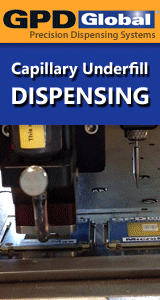Printed Circuit Board Assembly & PCB Design Forum
SMT electronics assembly manufacturing forum.
- SMTnet
- »
- Electronics Forum
- »
- Solder Paste and fine pitch components
Solder Paste and fine pitch components
![]() I am working with fine pitch components (15-20 mil) and havi...
- Sep 17, 2002
by
I am working with fine pitch components (15-20 mil) and havi...
- Sep 17, 2002
by
![]()
![]() Where I worked previously we had some boards with a couple 1...
- Sep 17, 2002
by
Stephen
Where I worked previously we had some boards with a couple 1...
- Sep 17, 2002
by
Stephen
![]()
![]()
![]() 1) For solder short, pls check the paste height.
Too mu...
- Sep 18, 2002
by
1) For solder short, pls check the paste height.
Too mu...
- Sep 18, 2002
by
![]()
![]() I place 15-20 mil a lot. You need to look at your pad to apa...
- Sep 18, 2002
by
I place 15-20 mil a lot. You need to look at your pad to apa...
- Sep 18, 2002
by
![]()
![]()
![]() My suggestion is to conduct a Design For Manufacturing (DFM)...
- Sep 18, 2002
by
dragonslayr
My suggestion is to conduct a Design For Manufacturing (DFM)...
- Sep 18, 2002
by
dragonslayr
![]()
![]()
![]() > Fourth -
> back to design of PCB. Are there sold...
- Sep 18, 2002
by
Stephen
> Fourth -
> back to design of PCB. Are there sold...
- Sep 18, 2002
by
Stephen
![]()
![]()
![]() People have made good comments. Additional points are:
* Y...
- Sep 18, 2002
by
davef
People have made good comments. Additional points are:
* Y...
- Sep 18, 2002
by
davef
![]()
![]()
![]() Fabs can produce a solder mask web between 20 pitch leads, b...
- Sep 18, 2002
by
davef
Fabs can produce a solder mask web between 20 pitch leads, b...
- Sep 18, 2002
by
davef
![]()
![]()
![]() One more variable I've remembered - pad height with respect ...
- Sep 18, 2002
by
dragonslayr
One more variable I've remembered - pad height with respect ...
- Sep 18, 2002
by
dragonslayr
![]()
![]()
![]() I'm with you dave...please provide specifics as to defect co...
- Sep 18, 2002
by
scottefiske
I'm with you dave...please provide specifics as to defect co...
- Sep 18, 2002
by
scottefiske
![]()
![]()
![]() We had lots of problems with bridging on 15.8mm pitch, QFP17...
- Sep 19, 2002
by
We had lots of problems with bridging on 15.8mm pitch, QFP17...
- Sep 19, 2002
by
![]()
![]() I would like to thank everyone for their time and replies
...
- Sep 19, 2002
by
I would like to thank everyone for their time and replies
...
- Sep 19, 2002
by
![]()
![]() If I were you I would contact your solder paste applications...
- Sep 20, 2002
by
bill yates
If I were you I would contact your solder paste applications...
- Sep 20, 2002
by
bill yates
![]()
ccross
- SMTnet
- »
- Electronics Forum
- »
- Solder Paste and fine pitch components








